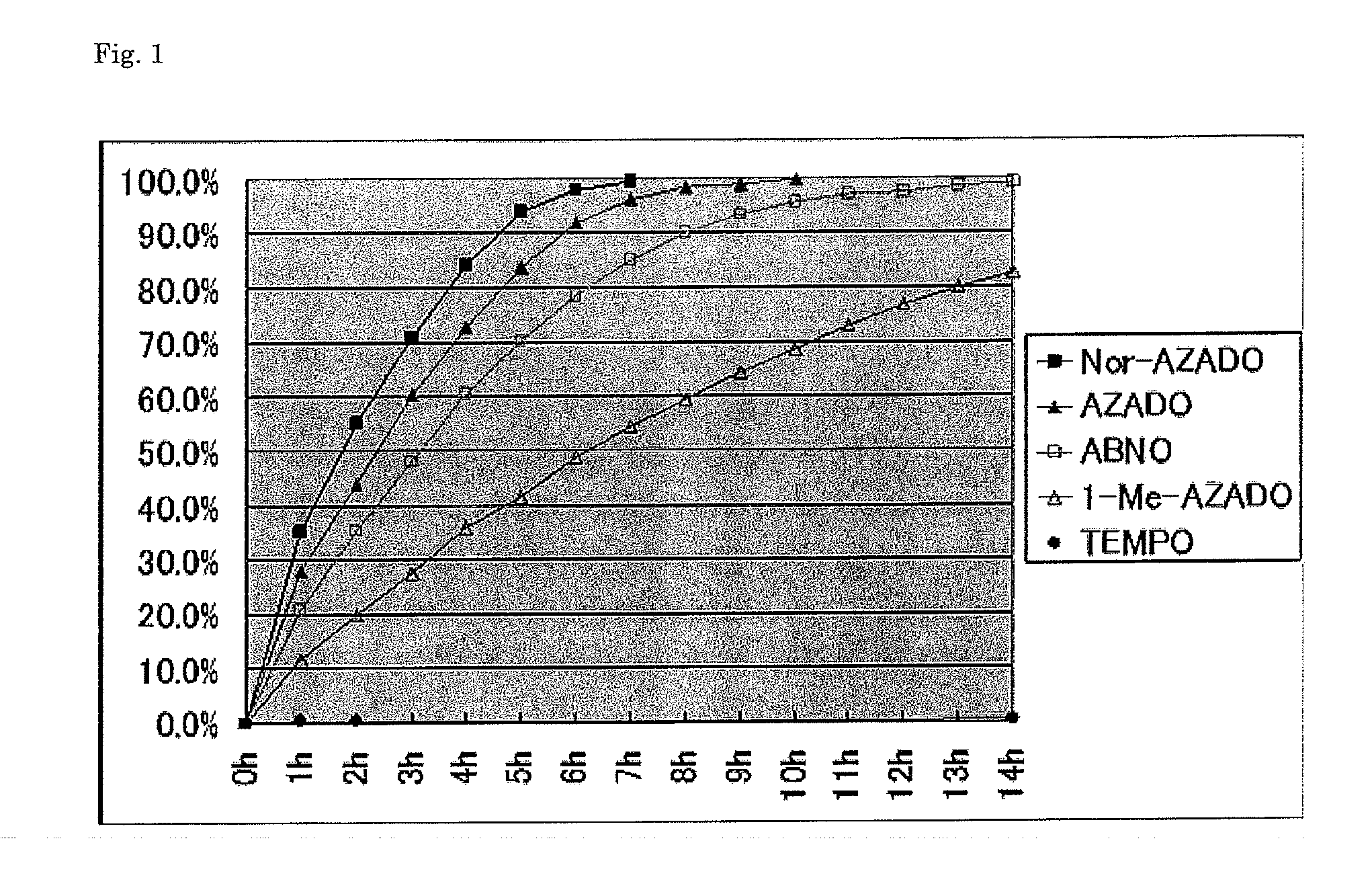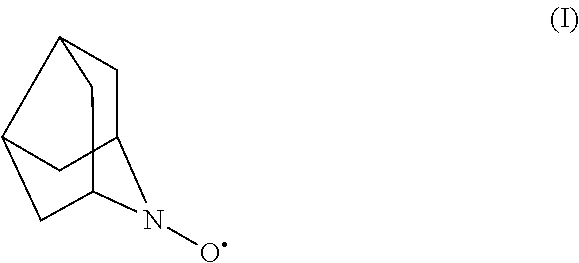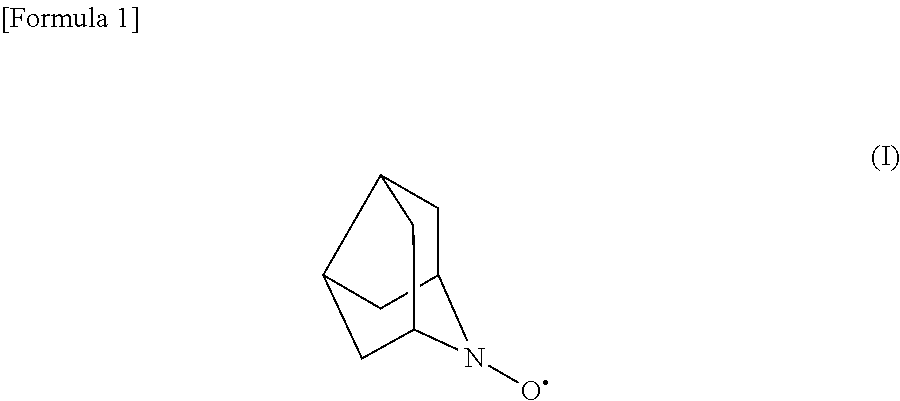Method for oxidizing alcohols
a technology of oxidizing alcohol and alcohol, which is applied in the preparation of carbonyl compounds by oxidation, physical/chemical process catalysts, organic compounds/hydrides/coordination complexes, etc. it can solve the problems of low reactivity of oxidation, heavy environmental impact, and the need for seven steps from a commercially available compound, so as to achieve efficient oxidation and reduce cost. , the effect of saving resources
- Summary
- Abstract
- Description
- Claims
- Application Information
AI Technical Summary
Benefits of technology
Problems solved by technology
Method used
Image
Examples
example 1
(a) Synthesis of 9-benzyl-9-azabicyclo[3.3.1]nonan-3-one
[0046]
[0047]A solution of acetonedicarboxylic acid (16.1 g, 109.9 mmol) in a mixture of acetic acid (46 ml) and water (92 ml) was successively added dropwise with 50% aqueous glutaraldehyde (26.5 ml, 146.5 mmol), and benzylamine (10 ml, 91.6 mmol) at room temperature, and then the mixture was stirred at the same temperature for 9 hours. The reaction mixture was added with dichloromethane (50 ml), and made basic by addition of 5 M aqueous sodium hydroxide (180 ml), and the mixture was extracted with dichloromethane. The organic layer was washed with saturated brine, and then dried over sodium sulfate. The organic layer was concentrated under reduced pressure, and then the residue was purified by silica gel column chromatography to obtain crude crystals (17.2 g). The crude crystals were added with ethyl acetate (5 ml) and hexane (50 ml), and the slurry was stirred for 24 hours. The crystals were collected by filtration, washed wi...
example 2
[0073]Oxidation reactions of alcohols were performed by using sodium hypochlorite as the bulk oxidant. Catalytic activities of Nor-AZADO as well as TEMPO, 1-Me-AZADO, AZADO, and ABNO for comparison were compared. The results are shown in Table 1.
TABLE 1catalysten-lordingammountyieldtrysubstratesproducts(mol %)timeTEMPO1-Me-AZADOAZADOABNONor-AZADO11 0.01 0.00320 min 20 min 30 min89% 19% n.d.*191% 89% 79%91% 88% 82% 91% 83% 59%92% 89% 82%21 0.01 0.00320 min 30 min 40 min97% 20% n.d.*199% 97% 67%99% 99% 74%100% 94% 24%99% 99% 92%31 0.01 0.00320 min 30 min 40 min5% n.d.*1 n.d.*195% 61% 25%99% 98% 87% 94% 95% 8%99% 98% 92%*1not determined.
[0074]In the oxidation of 4-phenylbutanol (entry 1), which is a primary alcohol, when the catalyst amount was 1 mol %, all the catalyst compounds gave the objective substance in a high yield, but when the catalyst amount was reduced, marked differences was observed in the catalytic activity. Specifically, in the case of using TEMPO, w...
example 3
[0077]Catalytic activities for oxidation of alcohols using air as the bulk oxidant were compared. The results are shown in Table 2.
TABLE 2Conversion* (time)entrysubstratesproductsTEMPO1-Me-AZADOAZADOABNONor-AZADO15% (13 h)99% (9 h)100% (7 h)99% (12 h)100% (6 h)20% (14 h)83% (14 h)100% (10 h)99% (14 h)100% (7 h)30% (14 h)99% (10 h)100% (8 h)99% (10 h)100% (6 h)*GC
[0078]It was revealed that, also under the air oxidation condition, Nor-AZADO had higher catalytic activity compared with the conventional catalysts. In the entries 1, 2, and 3, the reaction advanced at a high conversion rate with Nor-AZADO, 1-Me-AZADO, AZADO, and ABNO, whereas no reaction advanced or almost no reaction advanced with TEMPO. As a result of comparison of the reaction times, it was revealed that when Nor-AZADO was used, the reaction was completed in the shortest times for all the substrates, and thus Nor-AZADO had the highest activity among all the catalysts including the conventional catalysts. Change of the c...
PUM
| Property | Measurement | Unit |
|---|---|---|
| temperature | aaaaa | aaaaa |
| mol % | aaaaa | aaaaa |
| mol % | aaaaa | aaaaa |
Abstract
Description
Claims
Application Information
 Login to View More
Login to View More - R&D
- Intellectual Property
- Life Sciences
- Materials
- Tech Scout
- Unparalleled Data Quality
- Higher Quality Content
- 60% Fewer Hallucinations
Browse by: Latest US Patents, China's latest patents, Technical Efficacy Thesaurus, Application Domain, Technology Topic, Popular Technical Reports.
© 2025 PatSnap. All rights reserved.Legal|Privacy policy|Modern Slavery Act Transparency Statement|Sitemap|About US| Contact US: help@patsnap.com



